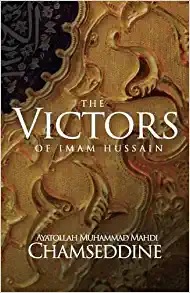The Victors of Imam Hussain
 | |
| Author | Shaykh Muhammad Mahdi Shams al-Din |
|---|---|
| Language | English |
| Published | 2016 |
| Publisher | The Mainstay Foundation |
| Pages | 282 |
The book The Victors of Imam Hussain provides great insight into the movement of Imam Hussain and its impact in changing history.
About the author
Ayatollah Sheikh Muhammad Mahdi Chamseddine (born in 1936) was a prominent Shia-Lebanese religious scholar, intellectual, and public figure. He was one of the founders of the Supreme Shia Islamic Council in Lebanon, along with Sayyid Musa Al-Sadr and others. Chamseddine and Sadr were heavily involved in preaching a moderate understanding of Islam that espoused plurality and coexistence at a time when Lebanon was going through an extreme period of violent civil war. After the disappearance of Sadr in 1978, Chamseddine rose to the forefront as his successor. Chamseddine was not only a religious figure, but a public intellectual and political thinker. He led Lebanon in its national and political introspection, always calling for inter-faith and intra-faith dialogue. He made the unity and advancement of Lebanon his priority through his calls for civic engagement, national sovereignty, and resistance to occupation. At the same time, his theory of political legitimacy was based on notions of social contract and popular sovereignty, as opposed to other prevalent Islamist ideologies at the time. I one of his most influential books Nidham Al-Hukm Wa Al-Idara fi Al-Islam (The System of Government and Public Administration in Islam), Chamseddine set out his theory of national sovereignty based on Islamic teachings that gave religious legitimacy to representative government. He passed away due to illness at age 65 in 2001.
About the book
This book written by Ayatollah Muhammad Mahdi Chemseddinc and translated and edited by Tlie Mainstay Foundation, is published in The Mainstay Foundation, (March 9, 2016). It has 282 pages and best sellers rank of 231,902 in Books. This work sheds light on individuals who came to support Imam Hussain in his movement and their backgrounds. It also looks into the discrepancies found in history’s account of the quantity and traits of Hussain’s supporters.
Abstract of chapters
Introduction
This study represents a novel method in dealing with and understanding historical texts, especially regarding that which is related to the study of revolutions and the masses behind those revolutions in Islamic history. It consists of these parts:
- Introductions: Regarding the dimensions of the idea and its objectives, as well as the sources cited in the study.
- How many are they and who are they? Regarding the martyrs of Imam Hussain revolution -the Hashimids and others in Karbala and Kufa. This includes a description of each of them within the limitations of the information available about each of them.
- Implications that can be concluded from the information relating to these personalities, the condition of die state and society, and the circumstances leading up to, during and following the battle.
- Prologue
This study covers the revolutionaries or the masses supporting the revolution who - for one reason or another - missed the opportunity to participate in the revolution when it took place, albeit while remaining loyal to it. This chapter examines this dimension of Imam Hussain’s revolution which is necessary to achieve two objectives:
- First: Knowing the “degree” that the “revolutionary state” in Islamic society at the time had reached.
- Second: Knowing the extent to which the martyrdom of the revolutionaries in Karbala’ and elsewhere contributed to fanning the flames of the revolutions that later broke out.
The Men
This chapter provides four narrations in regards to those who participated in the battle from the Hashimites and the non-Hashimites.
Indications
In this chapter the author examines the relationship of the Mawali with Hussain’s Revolution and the proofs of this relationship and excludes the Mawali of Hussain and Ali because their relationship is natural, deriving from the fact that their masters are its leaders. He also examines the signs of this hypothesis, which says that most of the non-Hashemite revolutionaries are Southern Arabs from Yemen.
Addendum
In this part the author includes the text of the ziyarah (visit salutation) attributed to al-Nahiyah al-Muqaddasah as well as al-Ziyarah al-Rajabiyyah (visit salutation of Rajab). There is also an important chapter investigating the status of these two ziyarahs due to them being sources cited in this study, in which he favors reliance on the ziyarah attributed to al-Nahiyah and considers al-Ziyarah al-Rajabiyyah to be a secondary, unimportant source.